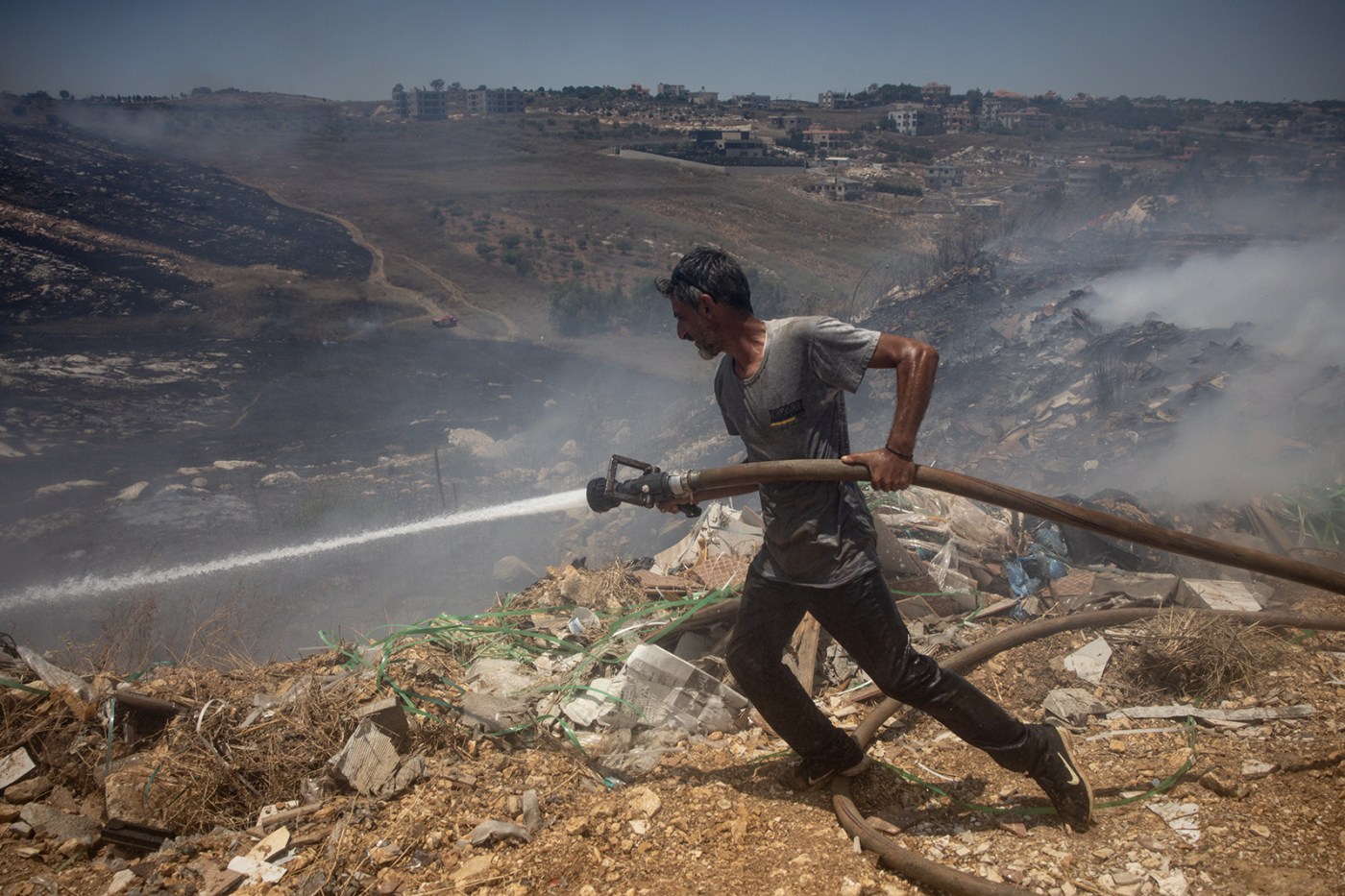North Israel is a series of ghost towns — abandoned houses and scorched forests from Hezbollah missiles. Parts of south Lebanon have been hit so hard by Israeli bombs that they’ve been reduced to rubble. Tens of thousands of residents have been driven from homes on both sides.
A steady, if ugly, tit-for-tat between Israel and Hezbollah since the October outbreak of the Gaza war has been shifting into something more alarming.
Record numbers of Hezbollah projectiles — some 900 — have hit Israel this month and its chief says he’s overwhelmed by volunteers ready to fight Israel “without any rules, restraints or ceiling.” Israel, meanwhile, is carrying out deeper and more destructive attacks in Lebanon and its northern military command has just approved a battle plan for the country.
While Iran-backed Hezbollah and Israel say they do not want a full-blown war, concern is higher than ever they’re stumbling into one — or will deliberately start one. Israelis advocating it believe that such a conflict could be kept short, a matter of weeks. Others are far more pessimistic.
Related Articles
A Northern California father who lost 2 sons in a Boeing Max crash waits to hear if the US will prosecute the company
Mexican attorney linked to botched hit on journalist agrees to extradition from California
UK parliament member accuses ‘Baby Reindeer’s real-life Martha of stalking, says he’s ‘ready to testify’
Ballot box binge: Votes loom in coming days from Mongolia to Iran to Britain in a busy election year
Julian Assange is now free to do or say whatever he likes. What does his future hold?
The Middle East could be in for “a major regional war, rising oil prices and plunging financial markets,” Aaron David Miller, a Carnegie Endowment for International Peace Senior Fellow and former State Department Arab-Israeli negotiator, told Bloomberg TV. “No one wants to see anything like that.”
Senior U.S. and French diplomats have visited Jerusalem and Beirut as part of an intense push to stave off escalation that could draw in Iran, along with its allied militias in Iraq, Syria and Yemen as well as the U.S. President Joe Biden is especially keen to avoid a new war so close to November’s elections. While Washington doesn’t communicate directly with Hezbollah, it uses Lebanon’s speaker of parliament, Nabih Berri, as a conduit.
The plan to end hostilities hinges on Hezbollah moving its fighters from the border. While U.N. Security Council Resolution 1701, which was passed in 2006 after the last round of combat between Israel and Hezbollah, requires it to be some 30 km (18 miles), negotiations are starting with 10 km. They would be replaced by international forces and members of the Lebanese army while a panel would address disputes over the shared boundary line.
But Hezbollah says the current round of tension has a source — the war in Gaza — and a solution — a Gaza cease-fire. Only once Israel and Hamas put down their arms, Hezbollah says, will it be open to its own border negotiations.
Berri told a U.S. envoy, Amos Hochstein, last week that the most he can do is lean on the group to reduce tensions by not firing too deeply into Israeli territory, according to a Lebanese official briefed on the talks. Visiting Washington this week, Israeli Defense Minister Yoav Gallant is being urged to give diplomacy a chance and hold off any military expansion.
“One rash move, one miscalculation could trigger a catastrophe that goes far beyond the borders and, frankly, beyond imagination,” warned United Nations Secretary General Antonio Guterres last week. “Let’s be clear. The people of the region and the people of the world cannot afford Lebanon to become another Gaza.”
Parallels with Gaza are inevitable and real: Hamas and Hezbollah, viewed as terrorist groups by the U.S., are heavily backed by Iran. Both consider Israel illegitimate and their conflict with it to be holy and existential. And just as Hamas in Gaza was born in the 1980s as a militant movement challenging Israeli occupation, so too was Hezbollah in Lebanon.
But important distinctions mean war with Hezbollah would be even more devastating.
The group is much more important to Iran than Hamas. And as traumatic as the Oct. 7 attack by Hamas was for Israel, Hezbollah is a much more powerful military force.
Through intense focus and preparation over the past 18 years, it has assembled perhaps 100,000 men while amassing 150,000 rockets and missiles, about half of which can reach major Israeli cities, along with a growing arsenal of attack drones.
Israel’s lauded air defense systems — Iron Dome, David’s Sling, Arrow — would be overwhelmed by a Hezbollah assault expected to amount to 3,000 rockets a day for weeks — especially if it were joined by other militias in Syria, Iraq and Yemen. Power stations, offshore gas rigs, military bases, airports and thousands of ordinary citizens would be at risk, as illustrated in a video released by Hezbollah last week showing drone footage of key facilities that it would target.
Pressure on the economy would be immense. The chief economist of Israel’s finance ministry estimates GDP growth rate would fall from a current 1.9% to -1.5% because of reserve recruitment and disruptions to infrastructure and education, and that would likely lead to a further credit downgrade for the country.
On the other side of the border, the picture would be even more grim, starting from a much more dire place.
Neighborhoods in southern Lebanese villages, including Aita Al-Shaab, Aytaroun and Khiyam, have been leveled by Israeli air strikes, prompting thousands of people to flee and straining an economy still reeling from a financial meltdown four years ago that saw the country default on its Eurobonds for the first time in its history and the currency collapse.
When the 2006 war ended after 34 days, Arab Gulf countries pledged billions to help Lebanon rebuild infrastructure including airports, ports, telecom towers, power plants and bridges as far as 140 km from the border with Israel.
The Lebanese public isn’t interested in another round of combat, which would bring more death, injury and damage that might never be repaired. It’s a different Middle East today. Saudi Arabia — once a key donor with significant influence in Lebanese politics — has lost interest, leaving Shiite Muslims led by Hezbollah to become the unrivaled power in the country.
“I don’t think any of the potential belligerents actually want to see a war or conflict spread,” U.S. Secretary of State Antony Blinken said last week, but like Guterres, he noted that a miscalculation or misunderstanding could set one off.
Apart from its diplomats, Biden’s administration is using its supply chain — slowing weapons deliveries to Israel — to try to avoid a broader conflict. It is assuring Israel of help if war erupts while stopping short of promising all out support.
In truth, Israel wouldn’t want to open a second front until its campaign against Hamas in Gaza is over. That could be weeks or months.
Yet Israelis consider Hezbollah’s barrage of rockets and missiles to be acts of pure aggression. So, Prime Minister Benjamin Netanyahu would have broad public support for his threats to push Hezbollah away from the border, despite all the risks.
“You have a lot of bluster going on between Hezbollah and the Israeli government at the moment, but that doesn’t mean it couldn’t spill over into something more serious,” Hagar Chemali, founder of Greenwich Media Strategies, a Connecticut-based geopolitical consultancy, told Bloomberg TV on June 21. “This summer is when we’ll see tensions increase significantly.”
©2024 Bloomberg L.P. Visit bloomberg.com. Distributed by Tribune Content Agency, LLC.












